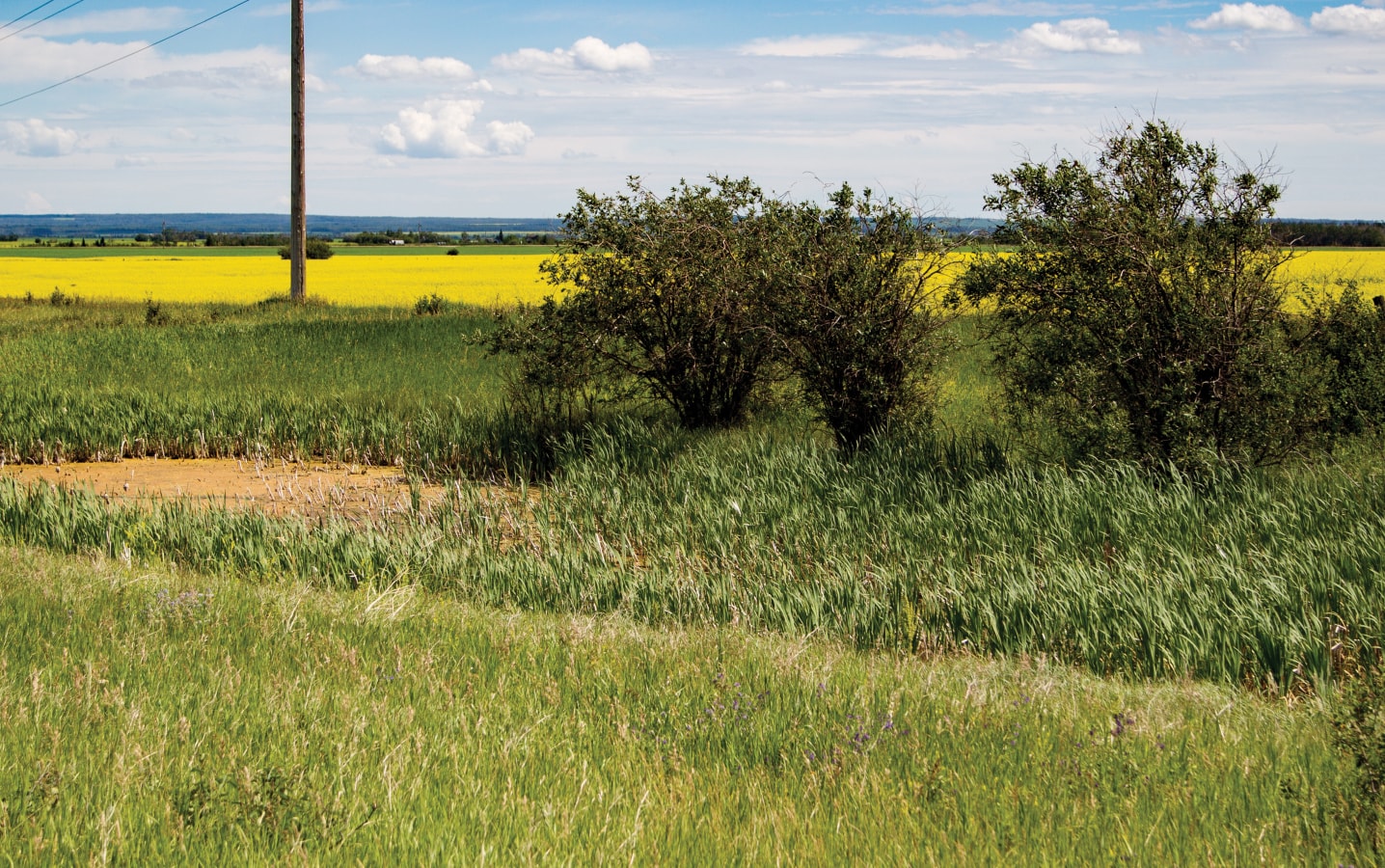Wetland monitoring demonstrates pesticide stewardship
By Émilie Bergeron and Mark Walker
Farmers know seed treatments on canola seeds are valuable to defend against flea beetles. But concern about seed treatments ending up in wetlands and affecting aquatic insects has been cited as a reason they should be phased out.
A water quality survey of 17 different wetlands in 2019 generated more data for the Pest Management Regulatory Agency (PMRA) review of neonicotinoid seed treatments. Funded by the Canadian Canola Growers Association (CCGA) and supported by the Canola Council of Canada (CCC) and product registrants, this initiative was in response to the potential loss of flea beetle seed treatments that include Prosper, Poncho, Helix and Cruiser Maxx. The monitoring showed that the practices Western Canadian canola growers use are protecting wetlands from seed treatment runoff.
“Science-based decision-making is key for our industry,” says Bernie McClean, a farmer from Glaslyn Sask., and CCGA president.
“With these water monitoring survey results, we created comprehensive and scientific real-world data that shows how we can use seed treatments and protect aquatic insects,” says Curtis Rempel, vice president, crop production & innovation with the CCC.
“The practices we use on our farms are an important part of what regulators consider when reviewing crop protection products. What farmers do is important to have the innovative products we need to farm sustainably and remain competitive.”
McClean describes the value in doing this work and relates it to on-farm practices. “Because crop protection products continue to face pressure from activists and the general public, the need for real-life data that supports science-based decisions will continue,” he says, adding, “We need to be prepared for that.” That means more surveys. It also means close attention to how wetlands and other sensitive areas are managed, as well as increased attention to how label uses and restrictions are followed.
“The practices we use on our farms are an important part of what regulators consider when reviewing crop protection products,” says McClean. “What farmers do is important to have the innovative products we need to farm sustainably and remain competitive.”
In fact, the potential risk of neonic seed treatments to aquatic invertebrates from seed treatments running off into wetlands was an important consideration that led the PMRA to propose phasing them out in 2018.
“A ban on neonic seed treatments could result in $700 million in losses each year for Canadian canola farmers, which is why neonics have been the top regulatory focus for the Canola Council over the past two years,” says Rempel.
A lack of real-life data demonstrating how seed treatments affect wetlands was cited by the PMRA in its decisions. A year and a half later, the PMRA is reviewing the information received during the consultation process – including the water monitoring data for wetlands around canola fields. Final decisions are expected in 2020.
Survey Results
The 17 wetland sites, including five in Alberta and 12 in Saskatchewan, were sampled weekly from the end of May until the second week of July. Extra sampling was done immediately after major rainfall events. A Government of Canada certified laboratory analyzed the samples and of the 157 samples taken, 80 per cent of them had no neonics detected. The other 20 per cent had extremely low levels, well below the PMRA’s established points of regulatory concern. Even after heavy rainfall, significant accumulation was not detected.
Curtis Rempel, vice president, crop production & innovation with
the CCC, says a ban on neonic seed treatments could result in $700 million in losses each year for Canadian canola farmers. “Which is why neonics have been the top regulatory focus for the Canola Council over the past two years,” he says.

These results align with results from the 2017 and 2018 water monitoring programs undertaken under the Agriculture and Agri-Food Canada Multi-Stakeholder Forum Environmental Water Monitoring Working Group. While waiting for the PMRA’s review and final decisions, CCC and CCGA will continue advocating for a national water monitoring program that will provide regulators with the data they need for evidence-based regulation of crop protection products in the future.
Effective Practices
The results of the water monitoring show that good on-farm practices help keep crop protection products out of wetlands. Conservation tillage limits soil movement, increases surface moisture and increases organic matter – all important to slow the movement of crop protection products and improve residual breakdown. The final step in keeping crop protection product residue out of wetlands is to maintain buffer strips. These vegetative buffer strips are effective tools to filter out crop protection products and keep them out of wetlands. Even in dry spring conditions when seeding into these areas may be possible, growers are still advised to leave these vegetative boundaries alone as they serve an important protective buffer between the field and the wetland.
Canada’s canola farmers continue to learn new ways to manage pesticides, and their continued use of best practices is proving effective at limiting pesticide runoff into wetlands. While the 2019 water monitoring survey results will help PMRA with its decision, these results also demonstrate the environmental responsibility of Canadian farmers.
—Émilie Bergeron is director, public affairs with the Canola Council of Canada in Ottawa. Mark Walker is policy manager with the Canadian Canola Growers Association in Winnipeg.





